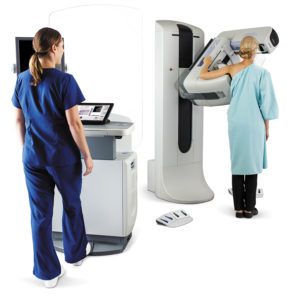By Joylin Isaacs Shirley – Guest Writer

When local women gather this month at the Ninth Annual Women’s Health & Breast Cancer Awareness Open House hosted by Venice Regional Bayfront Health, many will be breast cancer survivors. Survival rates are increasing as early detection and treatment are on the rise.
Today, new 3D mammography, also known as digital tomosynthesis, can detect breast cancer even earlier than standard 2D technology.
Imagine a book with clear covers and pages. With 2D digital mammography the radiologist must peer through the cover and all the pages at once, looking for a single word that does not have the same characteristics of all the other words. Since 3D mammography images the breast in discrete 1-millimeter slices, the radiologist now can look for that abnormal word one page at a time.
Peer-reviewed research has shown that when 3D imaging is added to standard 2D imaging, there is a 37 percent reduction in unnecessary patient callbacks. Industry research supports that 3D mammography is particularly helpful for women with dense breast tissue, a strong family history of breast cancer, a history of fibrocystic changes and women who are regularly called for additional tests.
More than 100 clinical studies on 3D mammography have shown that doctors are able to screen for breast cancer with much greater accuracy, regardless of a woman’s age or breast density.
Public Invited to Venice Regional’s Annual Women’s Health Open House
Join breast cancer survivors, physicians and caregivers for an informative and fun reception at Venice Regional’s Ninth Annual Women’s Health & Breast Cancer Awareness Open House on Thursday, October 11, 5:30-7 p.m. at Venice HealthPark, 1201 Jacaranda Boulevard in Venice. The free event will feature a speakers’ panel of physicians, exhibitors with information about women’s health, and door prizes. Space is limited. To register, visit www.veniceregional.com and click on Events or call 855-876-2362.
Greater accuracy means better breast cancer detection, potentially at an earlier stage when breast cancer is easier to treat. 3D mammography detects 41 percent more invasive cancers. When caught early, the five-year survival rate is 93-100 percent, depending on the stage.
3D mammography reduces callbacks by up to 40 percent. For many women, this means being spared the emotional, practical and economic toll of additional testing, including biopsies, when there could be nothing wrong.
Women who meet the eligibility requirements for screening and/or diagnostic mammograms may choose to have a 3D mammogram added to the standard 2D mammogram and are not required to have a physician order the 3D mammogram.
Both 3D and 2D mammograms are safe. Radiation exposure to the breast is very low. The radiation dose for a combined 2D/3D mammography exam is well below the acceptable limits defined by the FDA, and is only a fraction of the level of radiation everyone receives annually from the natural background of being outdoors. There is no evidence that this low level of radiation has any significant effect on the breasts.
There is no time or discomfort difference between a 3D and a 2D mammogram screening. During the 3D part of the exam, an X-ray arm sweeps over the breast, taking multiple images in seconds. Images are displayed as a series of thin slices that can be viewed by the radiologist as individual images or in a dynamic, interactive animation.
The 3D portion of the screening is very similar to having a traditional digital mammogram. The patient’s breast will be compressed, preventing motion and allowing the breast tissue to spread out.
Early detection using 3D mammography is the newest weapon in the fight against breast cancer. For information or to schedule a mammogram at Venice HealthPark, call 941-483-7634.
American Cancer Society
Breast Cancer Screening Guidelines
• Women between 40 and 44 have the option to start screening with a mammogram every year.
• Women 45 to 54 should get mammograms every year.
• Women 55 and older can switch to a mammogram every other year, or they can choose to continue yearly mammograms. Screening should continue as long as a woman is in good health and is expected to live 10 more years or longer.
These guidelines are for women at average risk for breast cancer. For screening purposes, a woman is at average risk if she doesn’t have a personal history of breast cancer, a strong family history of breast cancer, or a genetic mutation known to increase risk of breast cancer (such as in a BRCA gene), and has not had chest radiation therapy before the age of 30. For more information, visit www.cancer.org or call 1-800-227-2345.








